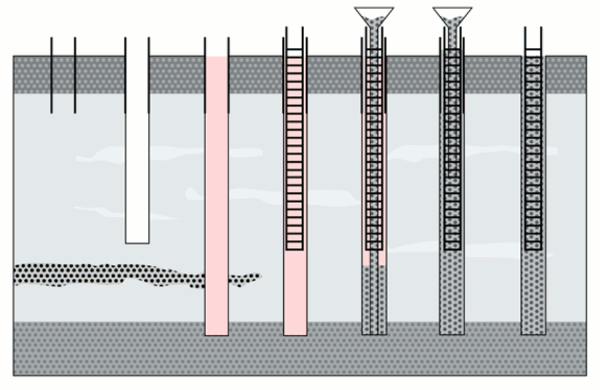Table of Contents
In this article, we will discuss Franki piles.
A Pile foundation is defined as a type of deep foundation that comprises a long, slender column used to transfer the load coming from the superstructure to the lower-lying ground thereby providing overall support to the structure.
In general, a pile foundation is a long cylinder usually made up of steel or concrete and driven deep into the ground to act as a base or support to the structure built on it.
Pile foundations transfer the load through skin friction or end bearing mechanism.
Sometimes, pile foundations made up of timber are also used.
Pile foundations are mostly used for large structures and when the upper soil layer is weak and does not have sufficient bearing capacity to withstand the imposed load.
1. Franki Piling System
The Franki piling system is also known as a Franki piling system. It is a technique utilized to drive expanded base cast-in-situ concrete piles. It was introduced by Belgian Engineer Edgard Frankignoul in 1909.
This technique can be involved in various site conditions and is still commonly utilized because of its high tensile load capacity, and moderately low noise and ground vibration levels.

Fig: Franki Piles
2. Uses of Franki Pile
Franki piles can be utilized as high-capacity deep foundation parts without the requirement of excavation or dewatering.
They are beneficial in conditions where a satisfactory bearing soil can only be advanced deeper in the ground and are best served in granular soil where the bearing is mainly performed from the densification of the soil around the base.
They are not suggested for utilization in cohesive soils where compaction of the base is not feasible. The Franki piling system is the most modest of the driven cast-in-place systems, and so is used in conditions where high noise levels could cause environmental problems.
3. Installing of Franki Piles
A charge of zero-slump concrete flows into the edge of a steel-driving pipe that is kept vertically on the ground. A diesel-operated drop hammer is then pushed on the concrete, forming a watertight concrete cork.
The concrete cork is pushed into the ground by the drop hammer. The pipe is also pulled into the ground because of friction introduced between the steel and the concrete.
When the preferred depth is achieved, the pipe is kept in position by leading structures that drive and align the pile and hammer. The hammer is then involved in the concrete, pushing it outwards through the bottom of the pile and creating a mushroom-shaped base.
At this point, a cylindrical rebar cage can be driven into the concrete if supplementary reinforcement is desired. Additional charges of concrete are added and driven while the steel casing is simultaneously pulled up until the shaft of the pile is formed.

4. Cast-in-Place Concrete Piles
Cast-in-place concrete is made by boring the soil up to a particularly preferred depth, filling it with freshly mixed concrete, and permitting it to dry on the field itself.
Normally, an outer metallic shell is first pushed into the ground and loaded with a fresh mix of concrete.
It is then allowed to be set and cured.
Finally, the outer metallic shell is removed or pulled out.

1. Advantages of Cast-In-Situ Concrete
Some of the advantages of cast-in-situ concrete piles can be listed as follows:
✔ They are more flexible in terms of length variation.
✔ Handling such piles is easier.
✔ Additional piles may be provided easily.
✔ The installation process is simple with no possibility of breakage.
2. Disadvantages of Cast-In-Situ Concrete
Some of the disadvantages of cast-in-situ concrete piles can be listed as follows:
✔ Since the pile is cast in situ, a proper storage place must be arranged for storing the construction materials safely.
✔ Quality control must be ensured during installation.
✔ The difficulty may arise in casting the concrete where the underground flow of water is relatively heavy.
| Read Also: Batching Plant |

